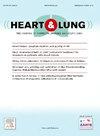Impact of rhBNP and ivabradine on outcomes, cardiac markers, and microcirculation in ischemic heart failure
IF 2.6
4区 医学
Q2 CARDIAC & CARDIOVASCULAR SYSTEMS
引用次数: 0
Abstract
Background
Ischemic cardiomyopathy (ICM) with heart failure (HF) is characterized by myocardial hypoxia, microcirculation dysfunction, and neuroendocrine activation. While ivabradine and recombinant human brain natriuretic peptide (rhBNP) are individually used for HF, their combined efficacy remains underexplored.
Objective
To evaluate the effects of rhBNP combined with ivabradine on cardiac function, myocardial microcirculation, endocrine hormones, and biomarkers (CysC, Gal-3, miR-19a) in ICM-HF patients.
Methods
In this prospective study, 126 ICM-HF patients were randomized 1:1 to either ivabradine alone (control) or rhBNP + ivabradine (intervention). Both groups received conventional therapy. Cardiac function (LVEF, LVESD, LVEDD), microcirculation parameters (ischemic burden, ST-segment shift), serum hormones (ALD, NE, Ang II), and biomarkers were assessed at baseline and after 1 month.
Results
The intervention group showed higher total efficacy (93.65%¦vs. 76.19%, P<0.05), improved LVEF (51.76%¦vs. 46.68%), and reduced ventricular volumes (LVESD: 34.75 vs. 40.47 mm; P<0.05). Myocardial microcirculation parameters (ischemic burden, time, frequency) and neuroendocrine levels (ALD: 38.31 vs. 65.02 ng/L; NE: 102.39 vs. 180.23 ng/L; P<0.05) were significantly lower. Serum CysC, Gal-3, and miR-19a levels also decreased more prominently (P<0.05). Adverse reactions were comparable (11.11%¦vs. 7.94%, P>0.05).
Conclusion
rhBNP combined with ivabradine synergistically improves cardiac function, myocardial microcirculation, and neuroendocrine regulation in ICM-HF patients, with superior efficacy and safety.
rhBNP和伊伐布雷定对缺血性心力衰竭结局、心脏指标和微循环的影响。
背景:缺血性心肌病(ICM)合并心力衰竭(HF)以心肌缺氧、微循环功能障碍和神经内分泌激活为特征。虽然伊伐布雷定和重组人脑利钠肽(rhBNP)单独用于治疗心衰,但它们的联合疗效仍未得到充分研究。目的:评价rhBNP联合伊伐布雷定对ICM-HF患者心功能、心肌微循环、内分泌激素及生物标志物(CysC、Gal-3、miR-19a)的影响。方法:在这项前瞻性研究中,126例ICM-HF患者以1:1的比例随机分为单独伊伐布雷定组(对照组)和rhBNP +伊伐布雷定组(干预组)。两组均接受常规治疗。在基线和1个月后评估心功能(LVEF、LVESD、LVEDD)、微循环参数(缺血负荷、st段移位)、血清激素(ALD、NE、Ang II)和生物标志物。结果:干预组总有效率高于对照组(93.65%)。76.19%, P0.05)。结论:rhBNP联合伊伐布雷定可协同改善ICM-HF患者心功能、心肌微循环及神经内分泌调节,具有较好的疗效和安全性。
本文章由计算机程序翻译,如有差异,请以英文原文为准。
求助全文
约1分钟内获得全文
求助全文
来源期刊

Heart & Lung
医学-呼吸系统
CiteScore
4.60
自引率
3.60%
发文量
184
审稿时长
35 days
期刊介绍:
Heart & Lung: The Journal of Cardiopulmonary and Acute Care, the official publication of The American Association of Heart Failure Nurses, presents original, peer-reviewed articles on techniques, advances, investigations, and observations related to the care of patients with acute and critical illness and patients with chronic cardiac or pulmonary disorders.
The Journal''s acute care articles focus on the care of hospitalized patients, including those in the critical and acute care settings. Because most patients who are hospitalized in acute and critical care settings have chronic conditions, we are also interested in the chronically critically ill, the care of patients with chronic cardiopulmonary disorders, their rehabilitation, and disease prevention. The Journal''s heart failure articles focus on all aspects of the care of patients with this condition. Manuscripts that are relevant to populations across the human lifespan are welcome.
 求助内容:
求助内容: 应助结果提醒方式:
应助结果提醒方式:


